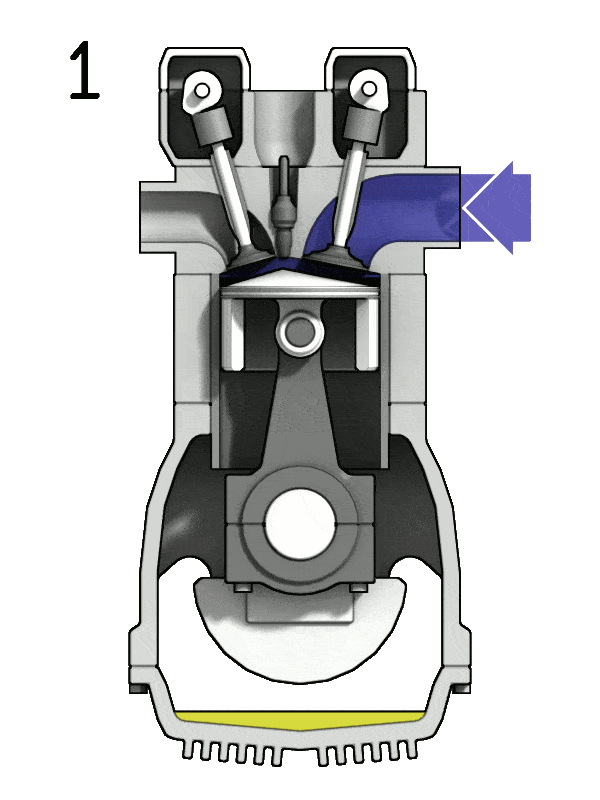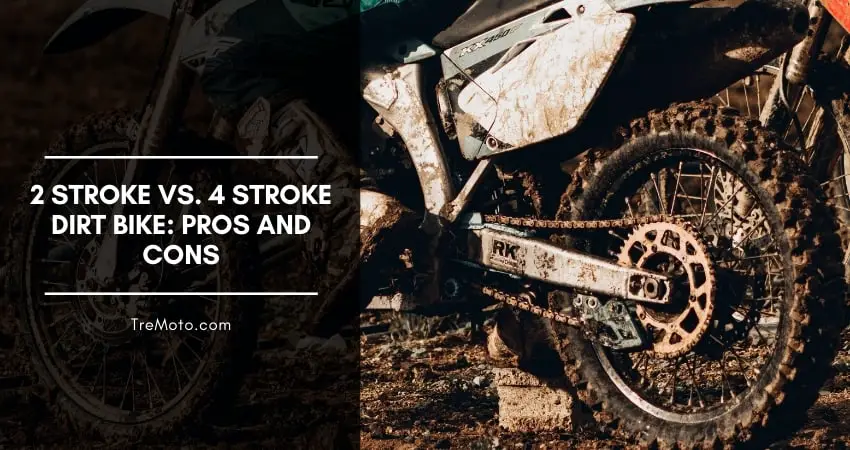“What are the differences between 2 stroke and 4 stroke dirt bikes?” 2 stroke vs. 4 stroke dirt bike, Which one is better?”. These are the questions roaming round and round in circles for ages. Dirt bikers everywhere swear by the efficiency of their preferred engine. But this age-old debate goes much deeper than that.
Here’s the thing. There’s no superior choice. They both offer unique advantages over one another. For example:
2-stroke engines are more powerful, meeting high octane demands of adventurous riders, however, 4-stroke engines are more efficient and environment-friendly. It can even handle heavier loads.
Picking between the two sounds like a tricky job, but I’m going to walk you through all of these and more. Hang on tight!
How do the engines work
To understand the difference between 2-stroke and 4-stroke, we need to know how they work. Both of the engines have top dead center (TDC) and bottom dead center(BDC). A piston and a crankshaft do the majority of the work.

When the piston reaches the top, it’s TDC, and when it’s in the bottom, it’s the BDC. Both of them work in four steps to complete the cycles. The piston and crankshaft keep the engine running.
In essence, The movement of the piston inside the cylinder is called a stroke. When the piston moves from the top dead center to the bottom dead center during the cycle, a stroke happens.
Internal combustion engines have five cycles-
- Intake- where fuel enters
- Compression- the fuel is compressed
- Ignition- depending on the fuel type, it will be set ablaze with a spark or put under severe pressure
- Combustion- the fuel will explode, and the engine will use it as a power source
- Exhaust- the leftovers are cast outside
This is how an engine completes its work. 4-stroke and 2-stroke engines here differ quite a bit. More onto this down below:
Difference between Two-stroke and Four-stroke
Both of them work differently in different situations and settings. So, it all comes down to the rider’s preference and riding style.
If you want to figure out which one of the two would be better for you, you need to understand the basics. E.g. “What even is a stroke? How do the engines work? What are their pros and cons? Which one would be more compatible with your style?”
Seems a bit much to take in, right? I got your back, just stay with me!

To understand the difference between the two gasoline-powered combustion engines, first, you need to understand the engine’s relation with strokes..
The two-stroke engine completes the entire cycle with two movements or “strokes”, while the four-stroke engine uses four strokes of the piston.
Also, the two-stroke engines have one input port and one exhaust port, while the four-stroke engines have an exhaust valve and an input valve. The fuel enters and emits through them in the form of gas
4-stroke engines are comparatively quieter as well. There’s also the benefit of not requiring fuel pre-mixing like a 2-stroke does. Additionally, because of having a wide powerband, you can remain worry-less about shifting and clutches; enabling you to enjoy your ride more.
By the way, if you want to learn about powerbands a bit more, I have a separate article explaining all about it right here.
Not just that, the 2 engines are different in torque generation as well. A 2-stroke engine generates more torque at a high RPM, while a 4-stroke does it at a lower RPM.
If you are fairly new to the world of dirtbikes, I’d suggest you start with a 4-stroke dirt bike since they are pretty reliable and you don’t have to worry much about balancing. You should opt for a 2-stroke bike if track riding appeals to you.
Now that we got that out of our way let’s dive into the deets.
Additional Read: What kind of gas does a dirt bike take?
2 stroke dirt bike
The two-stroke engine completes the cycle with two main functions that happen simultaneously.
The cycle starts with a combustion stroke. It occurs when the piston reaches the top dead center, causing the pre-mixed fuel, air, and the fire from the spark plug to burn together. And since combustion happens in a closed space, it creates an explosion that pushes the piston down.
Every time the piston reaches TDC, an input port opens, and a fresh air-fuel mixture enters the crank chamber. And when the piston moves back down, the exhaust channel opens, and the fresh fuel mixture flushes out the residual gas from the previous combustion through it.
The crankcase keeps pushing the piston back up to make another combustion happen. The whole thing repeats itself over and over again to keep the engine running.
So basically, the two-stroke engine completes a handful of actions in only two motions. Fascinating, right?
Now that we know how the two-stroke bike engine works, let’s compare all the pros and cons to see if it’s the right bike for you.
Pros of a 2-stroke engine
- Simple design
- Smaller and lighter
- Can accelerate and decelerate much quicker
- Cheaper and easier to handle
- Reliable
- Easily cleanable
- Produces more power
- Excellent for short distance riding
Cons of a 2-stroke engine
- Not environment-friendly
- Generate a lot of smoke
- Higher fuel consumption
- Parts get worn out fast
- Frequent maintenance is required
- Need to premix fuels
- Less fuel-efficient
- Can be a little jumpy
4 stroke dirt bike
As the name suggests, it requires four up and down motions of the piston for the engine to complete a cycle.
In the first input stroke, the piston moves downwards and lets the air and fuel enter through the input valve. Then the crankshaft pushes the piston back up for a compression stroke. The piston compresses the air and fuel into a highly combustible mixture.
At this point, the spark plug fires and pushes the piston downwards. This is called the combustion stroke. The piston again begins to travel upward, and the exhaust port opens, letting out all the burnt fuel and air mixture. When the piston reaches the top, the intake port opens, and the cycle starts all over again.
Now, there are many upsides to a four-stroke dirt bike. But at the end of the day, your preference and requirements matter the most. Keep on reading to find out if the 4 stroke dirt bike is suitable for you.
Pros of a 4-stroke engine
- Fuel-efficient
- Easier to ride and control
- Beginner-friendly
- Steady and manageable power output
- Smoother ride thanks to a wide powerband.
- Quieter than 2 strokes
- Environment friendly
- Have more torque at a lower RPM
Cons of a 4-stroke engine
- Maintenance can be quite expensive
- They have a higher number of parts than two-strokes, so it’s harder to clean
- Four-stroke dirt bikes are #heavier and complicated of the two, so it can be concerning if you are a racer because top speed is important
- They overheat easily
- Since four-stroke bike’s power gets delivered once every 2 rotation of the crankshaft, it’s less powerful than two-stroke bikes
So, which one is the right one for you?
Honestly, both 4-stroke and 2-stroke engines have their own perks and reasons as for why you should choose one over the other. I can’t give you a definite answer.
What I could do was give you a brief rundown on 2-stroke vs 4-stroke dirt bike engines and let you decide which of their features are more desirable to you.
So, by taking all of these into consideration, try to figure out what you will enjoy more.
